Beef Meatball With Tendon in the Blue Bag
Newly updated with a better result and enhanced recipe on September 2020.
These Vietnamese beef meatballs are one of my top favorites, so is my son and other family members. It doesn't matter what dish they are in, be it rice, soup, noodle, Pho, pizza, etc. As long as there are some meatballs in there, we would ask for a second filled.
You'll see, when cooking for that little sweetness, healthiness is a major concern. I mean, most store-bought meatballs these days would contain borax, an agent to easily make the meatballs crunchy no matter what meats are used. Plus, you don't know for sure what kinds of meat being used, their quality and freshness, not to mention bunches of extra undeclared ingredients.
That's why a perfectly safe homemade Beef meatball is worth it in my case. Since the passive time needed to rest and set the meat in the fridge are long, I always made these in large batches and stored in small quart-size zip-lock bags in the freezer. It's more convenient that way, plus I'm perfectly comfortable with what my boy is eating, considering this is his favorite food.
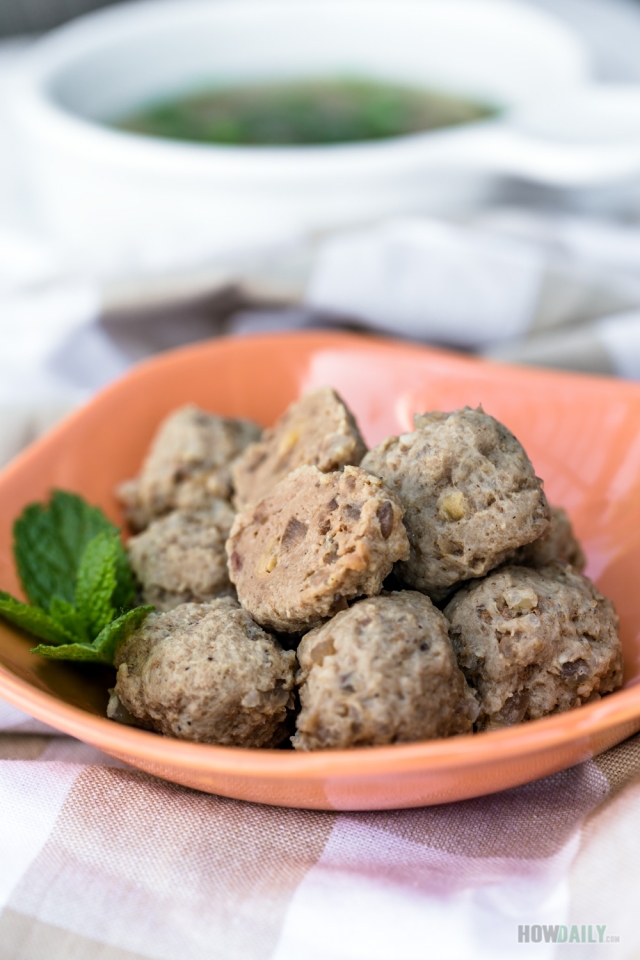
Now onto the meatballs, if you've ever eaten Pho – Vietnamese beef noodle soup, you would come across these, either as combination/standalone topping or in its own side soup bowl. Apart from that, there are many more applications. For example grilled meatball in chili sauce, fried appetizer with dipping sauce, use in hot pot, lunch box, etc. You could also slice them thin and put atop pizza or okonomiyaki like sausage or dice and mix into scrambled eggs. The application is limitless and only bound by your creativity.
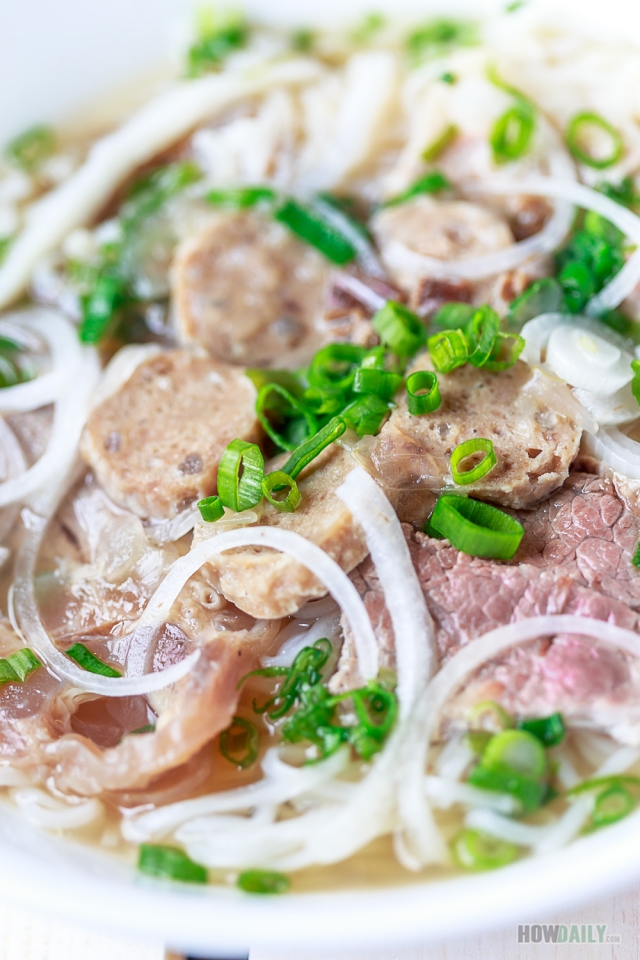
Vietnamese Pho with beef meatballs
On comparing to the regular meatball, the difference is mainly the crunchiness and rich flavor. You'll see, while Italian meatballs are moist and tender in every bite, Vietnamese beef meatballs are almost on the opposite ground. Good Vietnamese beef meatballs should be a crunch, little bit chewy, and rubbery with a spicy rich flavor. The shape is holding well, creating a smooth surface, whether on its outer skin or crosscut surface. There should be minimal air bubbles within each ball.
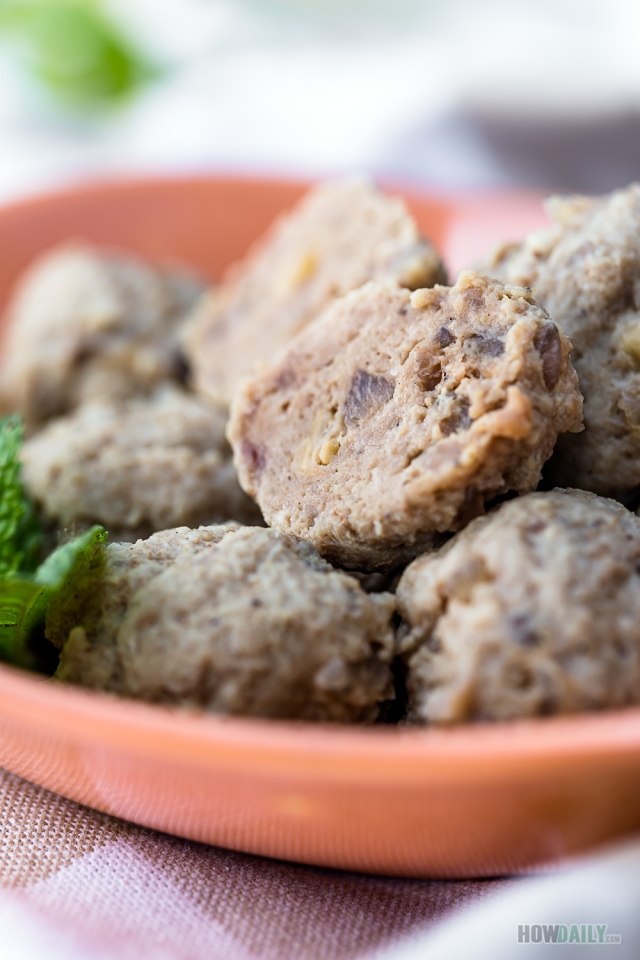
So, to achieve all of those requirements, we'd need a few techniques. First, by half-freezing, it's easier to grind your beef into paste-form without burning the tissue. It is vitally important the beef mixture is cold at all times when you are processing it, otherwise, you won't get that chewy, crunch and rubbery texture. The meat will not bind well on its own if it becomes hot at any point.
Second, by re-grinding multiple times, we are making sure the whole texture is smooth and extra-fine while firmly holding well together.
Adding tendon is for extra crunchiness to the teeth, as most Vietnamese tends to love this, but could be skipped without affecting the outcomes. You just have fewer meatballs, that is.
Last, a lot of ice was used, either to cool off the meat, set the baking powder, smooth the ball outer shell, etc. The main goal is keeping it cool while processing to preserve the crunch. So get a bag of ice ready for this if yours doesn't carry an ice maker.
Since we're making meatballs in batches, it's better to have some sort of large containers and equipment. You knew it, the larger the machine, the fewer batches to process. You don't want to burn the machine so divided the batch accordingly. In my case, 5 lbs of meatballs (4 lbs beef & 1 lb tendon) would require to process 3-4 times through my 16-cups food processor.
Luckily my stand mixer is large enough to contain everything in one go, so my hands were saved tremendously from all the pounding and kneading. So, start with half the recipe a couple of times, when you getting used to the hang of it, increase the batches as needed. A hand mixer would help too but beware that the beef paste will be thick.
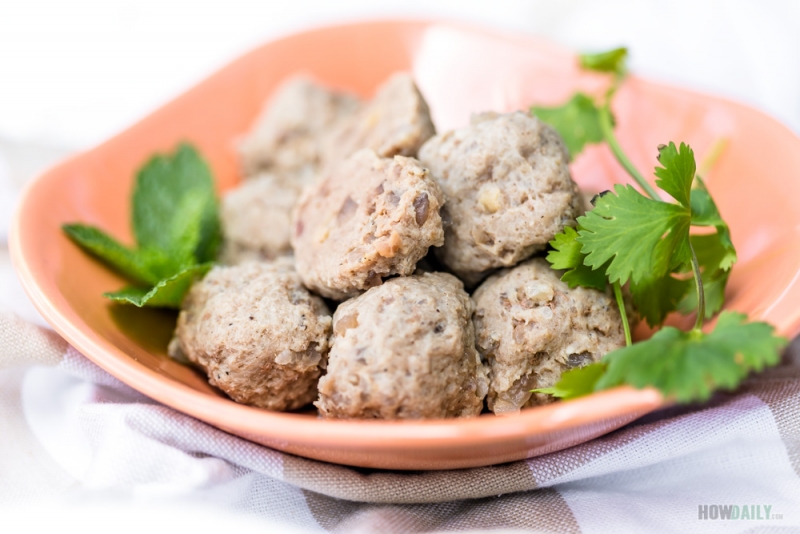
For forming/molding into a ball shape, I have tried many ways including simple pluck and mold in the palm, spoon form, ice sphere mold, sausage stuffer, pastry piping, corner-cut plastic bags… I would say anything would work, but the more complex method would provide better meatballs, i.e. totally smooth surface with less hole when cross-cut hence more crunch too. Here are my experiences with each method:
- Sausage stuffer: I found that by letting the beef paste through the mixer's attached sausage stuffing tube (without the usual casing), the paste coming out in a nice steady long string that is perfect to cut/pluck, mold, and cool. However, you would need a second hand to fill the feed parachute and be quite an experience (fast) informing/working through all the ball. Plus, there are just so many things to wash afterward.
- Hand pluck and form: this is the easiest and quickest method, however, unless you have a steady hand and are really experience with palm molding, most of the time will leave some sort of bubble in the core. Not to mention that when a lack of pressure, the tendon and meat paste will fall apart when boiling. Don't recommend the first try though.
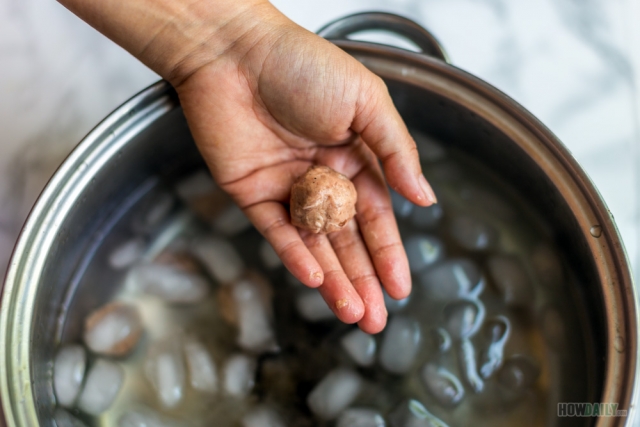
- Pastry piping/corner cut plastic bag: This is where the medians meet. I found that by using the pastry/plastic bag with a large coupler without a nozzle, of course, every time I squeeze will remove all of the air bubbles inside. A pastry bag is nice, but if you don't have one, use a large plastic bag and cut an inch off one corner. The pros are nice, bubble-free, and even stream of beef paste, not much to wash (just the coupler), no extra help need, work at your own pace vs stuffer feeding pace. Cons are you have to refill w/ beef paste many times and it's kind of harder to squeeze as your hands getting wet and slippery with all the beef fat. Anyhow, this is my go-to method as it fit my need, but you just try and see what suits your style.
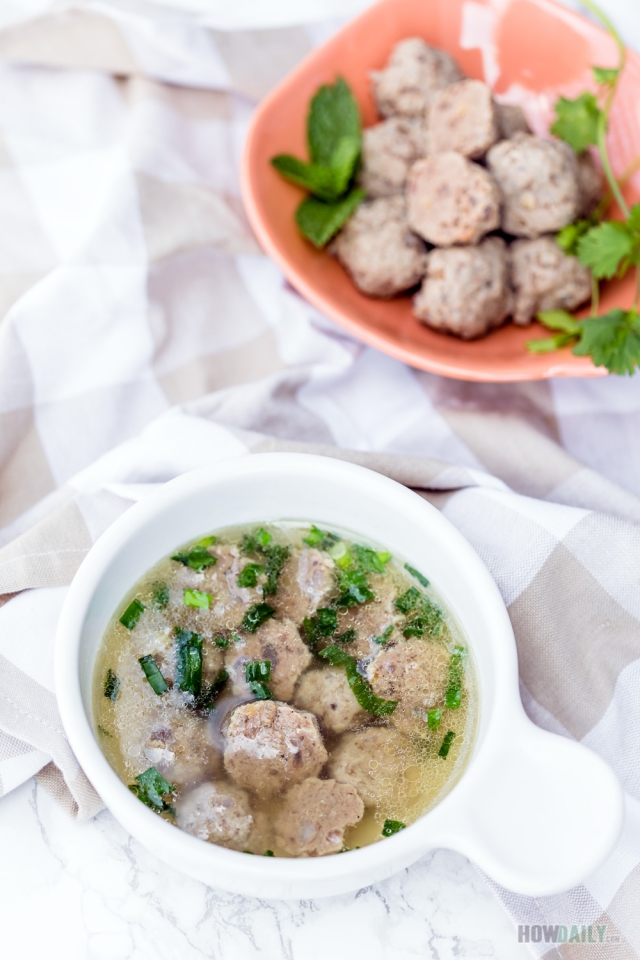
Oh and before diving into the recipe itself, it is worth mentioning that the beef quality does contribute to the final crunchiness. As all the ingredients are raw and fresh, plus since no borax is used, it's essential to choose your beef carefully. The beef has to be fresh and new, test for its elasticity, color, and temperature before buying. Also adding some rubbery texture by mixing with dense muscle tissues from shank, heel meat too. For the chuck, get them lean, 5-10% fat at most, as too much fat would result in moist and tender balls (the Italian version) instead.
Enough with all the long text, go ahead and try the recipe. Let me know your result.
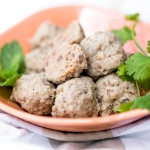
Recipe for Vietnamese Beef Meatballs with Tendon (Bo Vien Gan)
Servings: 5 lbs
This is the homemade version of the Crunchy beef meatball in Vietnamese style with the extra tendon. Rich in flavor, aromatic, and totally safe from raw ingredients. Recommend to be made in large batches due to the long passive time required.
- 4 lbs lean Ground beef chuck shank , stew chunk or mixed
- 2 tsp baking powder
- 8 Tbsp fish sauce
- 2 Tbsp sugar
- 2 tsp ground pepper
- 4 Tbsp potato starch
- 140 g crushed ice
- ½ cup vegetable oil
- lots of ice cubes for icy water bath
Tendon fillers (optional)
- 1 lbs tendon optional
- 2 Tbsp vodka or similar optional
- A quarter size piece of ginger optional
- 4 garlic cloves optional
Grind the beef
-
It's best to ask the butcher to grind the beef for you, if not, you can grind them yourself. To grind the beef, start by cutting them into 1-inch cubes.
-
Wrap all those cubes in a large plastic bag and chill in the freezer for 1 hour.
-
Remove the half-frozen beef from the freezer and grind them in the food processor, starting in small batches, one-by-one and work them through (I divided into 4 batches for grinding in my 16 cups food processor).

-
Use 4 quart-size freezer bags to store ground beef. Flattening the bags down so that ground beef will be chilled evenly. Chill the beefy bags in the freezer for an hour.
Regrind into paste
-
For each batch of half-frozen ground beef (1 freezer bag), divide and use 1/4 part of seasoning as the following.
-
First, take out 1 bag of half-frozen beef and add to food processor.
-
Now add 1/4 portion of the fish sauce, sugar, and ground pepper into the food processor and pulse/grind for about 20 -30 seconds.
-
Beef mixture should turn to a lighter pink and smooth to semi-paste-like texture with a few of darker spot. Transfer back to the freezer bag and chill for an hour.
-
Repeat with other remaining beef batches.
Regrind Paste – Second time
-
Take out 1 half-frozen beef-mixture bag and add to the food processor.
-
Also add ¼ of the baking powder, potato starch, vegetable oil, and crushed ice; then process on medium to high for 20-30 seconds.
-
Beef should be in paste-like texture, super smooth, and light pink color.
-
From here on, you can either mix with tendon or skip that step and go straight to the shaping and boiling steps.
(Optional) Tendon
-
If you choose not to use tendon, just skip this part of the procedure and go straight to shaping & boiling meatballs.
-
Start by washing tendon, patting dry before soaking with 2 Tbsp of wine (I used vodka) for 5-10 minutes. This will help removing any strange odor.
-
Pressure cooker: boil enough water, then add tendon and 1 Tbsp of salt, pressure cooked for 20 minutes so that tendon is almost done, but not fully tender. Vent manually.
-
Regular pot: boil tendon with 1 Tbsp of salt, but cook longer, 40-60 minutes
-
Prepare an icy cold water bath with 1 Tbsp lemon/lime juice, upon remove tendon, dip and soak them immediately in the cold water bath.
-
When the tendon is fully cool, cut it down to shorter length and throw into your food processor, pulse a few times to chop into smaller chunks, but not paste.
-
Grate ginger and finely mince garlic (if using) and mix together with the tendon bits.
-
Wrap tendon bits and store in the fridge until use. Do this while you're waiting for the beef mixture to chill in the freezer to save time.
-
Once you finished the second regrind paste step, take out tendon bits, divide and mix together the beef mixture. Use a stand mixer with a flat beater to achieve this. Don't prolong mixing time more than 30 sec, add crushed ice to cool the mixture down if you're in a hot climate.
Shaping and boiling
-
You want as low to no air bubbles as possible in every meatball. To achieve this, you could either use a pastry bag and large coupler (no nozzle), use a thick plastic bag and cut off one corner to an inch diameter, or simply pull and pluck with your hand (already coated in veggie oil). Just choose whichever works best for you.
-
Now let set up the working area. You will need a "before" icy water bath (to pre-chill meatballs), a large pot of water on the stovetop (to cook the meatballs), and a "finish" icy water bath (to help set the texture and quickly chill meatballs after cooking).
-
Depend on your pot/container capacity, you can work on them at once or divide them in bag like when you're grinding earlier.
-
Anyhow, Pipe or pluck to form ball-shape and drop each meatball into the icy-cold water bath. Doing this will help them retain their crunch and chewy texture while keeping their color on the brighter side.
-
Once you finish forming balls out of one beef batch, transfer the chilled meatball from the water bath into the boiling pot to cook them.
-
Meatballs will be floating up and inflating a bit when they are done cooking. So once done, transfer them out to the "finish" chilling bath.
-
When meatballs are fully cool down, transfer out to a mesh/drip baskets.
-
Now you can enjoy them immediately as an appetizer, use in other recipes like Pho, Pad Thai, stir-fried noodles, etc. Pat dry and store the remaining in freezer bags/containers for future use.
Source: https://howdaily.com/vietnamese-beef-meatballs-bo-vien/
0 Response to "Beef Meatball With Tendon in the Blue Bag"
Post a Comment